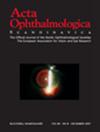Self-perceived and measured visual function, the impact of eye-disease, wellbeing, social determinants, and personality traits in Swedish 70-year-olds–results from the Gothenburg H70 Study
Abstract
Purpose
To explore the potential correlation between subjective and measured visual function, as well as to analyse the influence of eye disease, socioeconomic factors and emotional dimensions.
Methods
Semi-structured interviews, physical examinations and functional tests (n = 1203). Demographics covered sex, marital status, education, household economy, smoking and alcohol. Participants (born in 1944) rated their visual function (n = 533); those misjudging (n = 48) were studied. Group A (n = 18) had low presenting visual acuity (PVA) but reported good vision; Group B (n = 30) had normal PVA but reported low vision. Control group (n = 485) matched subjective and measured visual function. Ophthalmic examination tested visual acuity (VA), visual field and contrast sensitivity (CS). Psychometric tests: NEO-FFI, sense of coherence (SOC) and Montgomery–Åsberg Depression Rating Scale (MADRS). Statistical tests: chi-square, t-tests, Mann–Whitney U test and logistic regression.
Results
Of the population, 91% made correct assumptions about their vision. The 9% who made incorrect assumptions about their vision ability (combining groups A + B) were more likely to live alone (p = 0.02) and had lower household incomes compared to the control group (p = 0.04). Additionally, the exhibited significantly lower PVA and BCVA, a higher prevalence of visual field defects (p = 0.02) and lower CS, mean 1.63 (p = 0.005). Group A (3.4%) were women (p = 0.002) with the personality of extraversion, mean 40.0 (p = 0.01). Group B (5.6%) had more self-reported eye diseases (p = 0.01), lower CS (p = 0.01), lower educational level (p = 0.03) and border significantly lower SOC (p = 0.06).
Conclusions
The perception of visual function is shaped by awareness of an eye disease but is additionally influenced by sex, socioeconomic factors and emotional parameters.


 求助内容:
求助内容: 应助结果提醒方式:
应助结果提醒方式:


